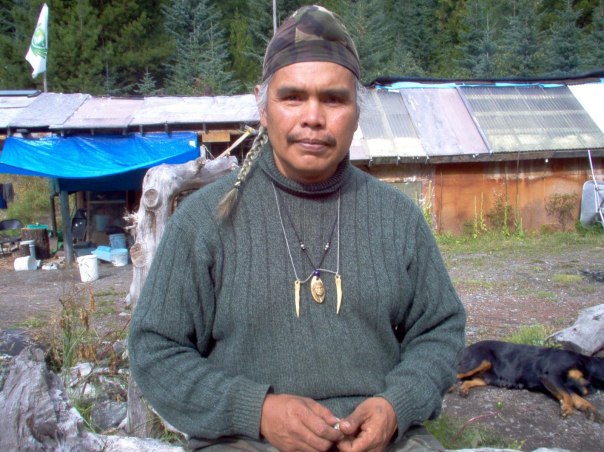15 Years of Resistance at Sutikalh
, Vancouver Observer,
Since 2000, Hubert Jim has watched over Sutikalh with an attentive eye and clear love for this place. From the nearby highway, following along a creek bed to a small opening, he occupies a lone cabin that was erected during a blockade.Fifteen years ago, Olympic gold medalist skier and now Conservative Party Senator Nancy Greene-Raine was given permits to develop a $500 million all-season ski and recreation resort. The project was to be located in the pristine wilderness of Cayoosh Canyon, originally and now known as Sutikalh, near Pemberton, British Columbia. The proposal was met with Indigenous opposition, both in the form of legal battles and a physical blockade. To date, it has never been built.Hubert Jim, known as Hubie to locals, has lived at Sutikalh since the blockade began. Outsiders commonly refer to Sutikalh as a “camp,” but Hubie explains “15 years is too long to call this place a camp, for me, its Sutikalh Home.” For Hubie, a typical day involves collecting wood, food and water, cooking, and keeping the cabin and grounds in living conditions. He says that within walking distance he can find 24 types of berries. He often awakes to many wild birds, including grouse and ptarmigan, as well as other animals near his cabin. Occasionally, he’ll see a flying squirrel in the woods. The area is habitat for mountain goats, grizzly bears, wolverines, hawks, amongst many other animals and plants. Living like he has at Sutikalh, Hubie has lost weight and celebrates the health benefits of the natural water, fresh air and consistent, moderate labour.
Conversely, there has been a regular pattern of harassment from the very start. Sometimes from backcountry skiers or snowmobilers, sometimes from locals or unknowns. Some people blame Hubie for keeping jobs from the area. More than once, trespassers have come armed with a gun.
There have been political complications, as well. Although at the surface Greene-Raine’s project appears a failure, the permits still sit as valid. Hubie says that he’s been relatively unbothered by them since 2005, five years after the original demonstrations. Development of the resort was pushed again at this time, leading up to the 2010 Vancouver Olympics. On the road to Sutikalh, there was once a car bridge built. After the resort was expected to collapse however, the government destroyed it. Now, a small wooden bridge leads to the trailhead, making Sutikalh less accessible. More recently the camp changed hands from being recognized St’át’imc land, to provincial park land. A provincial park comes with many stipulations. Importantly, it is now a public space, and anyone can enter. It is under British Columbia government ownership; and, last year’s provincial Bill-4 allows “feasibility studies” within park land that were previously prohibited. Bill-4 allows studies to be done for roads, highway, pipelines, transmission lines; as well as vague terms like “a prescribed project or a project in a prescribed class or projects” and “a structure [or] improvement.” In this land rights shift, some protection was lost.
Resistance at Sutikalh is much more than a tension between environment and economy. Sutikalh, which translates to ‘home of the winter spirit’, has long been a spiritual place for the eleven St’át’imc communities. St’át’imc Elder Rosalin Sam explains that Sutikalh has been used for purposes of gathering, but also a place of spiritual practice, including winter fasts and trips into the wilderness, trips that sometimes last as long as two months.
The Sutikalh resistance sits at the crux of what many Aboriginal communities in British Columbia and all over Canada are confronting. Their land was never ceded; their sovereignty never given up, and yet development without consent continues. Hubie himself has been called a terrorist training camp – of which he jokes, “a training camp of one” – for defending St’át’imc land. Indeed, the land of a community to which he belongs.
The eleven St’át’imc communities will celebrate 15 years of success against the resort proposal in May, 2015.
Posted on March 9, 2015, in Defending Territory and tagged cayoosh creek, land reclamation, reoccupation, St'at'imc, Sutikalh. Bookmark the permalink. 4 Comments.





Walyom, Csuyema7aska, Hubert JIM, is a great Hero and Role-model for us Indigenous Warriors & Leaders.–Tqelt7kukpi:Mawgcen Neskynilh. (04:10 PM) || (03/09/2015).
I haven’t even finished reading your story and I already find it more compelling than any book I’ve read. I am certainly related to you by blood as my father was from Pemberton. This may seem a little forward but I would like to talk to you further. You can call me at 250-537-9396. I think I’ll finish reading your story now. Hope to talk to you further. Jordan Soames is my name. Talk to you later.
Way to go Hubie. Thank you for protecting the land for all these years. So proud to be LilLil’Wat Nation. Take care .
Pingback: Their Country, Our Land: Indigenous peoples' problem with #Canada150